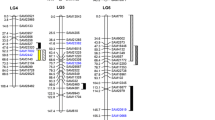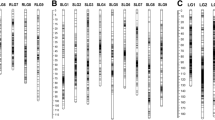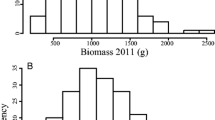Abstract
Selection of grazing-tolerant lucerne (Medicago sativa) germplasm with low autumn dormancy and erect growth habit, suitable to environments with mild winters, is hindered by genetically-based tradeoffs among these traits. Marker-assisted selection (MAS) may help overcoming the difficulty of phenotypic selection and hasten the breeding process. Over 400 progenies from four bi-parental crosses between contrasting parents from two cultivars were phenotyped for grazing tolerance and six other morpho-physiological characters. In parallel, genotyping-by-sequencing marker data were generated, with the objective to facilitate the multi-trait MAS by identifying quantitative trait loci (QTL) for the traits and assessing the extent of their co-location. In total, 9594 markers, with less than 20% missing data, segregated as simplex markers in at least one progeny family. Twenty-seven QTL were identified for six traits in the different bi-parental crosses. QTL were found to a different extent on all homology groups except homology group 4. No QTL was found for dry-matter yield before grazing imposition. The number of QTL for other traits varied from one (basal plant diameter) to nine (plant growth habit). Only for growth habit were QTL observed in all four crosses. The QTL analysis largely confirmed the association between grazing tolerance, non-erect growth habit and autumn dormancy. However, the absence of complete co-location of QTL highlighted a partly different genetic control of these traits, thereby offering scope for MAS exploitation to select genotypes carrying useful trait combinations.

Similar content being viewed by others
Availability of data and material
The genotyping data are available at https://doi.org/10.15454/RU4WRN.
References
Adhikari L, Lindstrom OM, Markham J, Missaoui AM (2018) Dissecting key adaptation traits in the polyploid perennial Medicago sativa using GBS-SNP mapping. Front Plant Sci 9:934. https://doi.org/10.3389/fpls.2018.00934
Annicchiarico P (2017) Feed legumes for truly sustainable crop-animal systems. It J Agron 12:880. https://doi.org/10.4081/ija.2017.880
Annicchiarico P, Scotti C, Carelli M, Pecetti L (2010) Questions and avenues for lucerne improvement. Czech J Genet Plant Breed 46:1–13. https://doi.org/10.17221/90/2009-CJGPB
Annicchiarico P, Nazzicari N, Li X, Wei Y, Pecetti L, Brummer EC (2015a) Accuracy of genomic selection for alfalfa biomass yield in different reference populations. BMC Genom 16:1020. https://doi.org/10.1186/s12864-015-2212-y
Annicchiarico P, Barrett B, Brummer EC, Julier B, Marshall AH (2015b) Achievements and challenges in improving temperate perennial forage legumes. Crit Rev Plant Sci 34:327–380. https://doi.org/10.1080/07352689.2014.898462
Benson GA (2008) Pasture-based and confinement dairy farming in the United States: an assessment. J Intern Farm Manag 4:1–16
Blondon F, Chesneaux MT, Guy P (1967) Action de photopériodes et de thermopériodes sur le comportement de deux types extrèmes de luzernes française, Medicago sativa L. Compte-Rendus De L’académie Des Sciences, Paris, Série D Sciences Naturelles 264:596–598
Bouton JH, Gates RN (2003) Grazing-tolerant alfalfa cultivars perform well under rotational stocking and hay management. Agron J 95:1461–1464
Bouton JH, Gates RN, Utley PR (1998) Persistence and yield among nondormant alfalfas selected for grazing tolerance. J Prod Agric 11:314–318
Charrier X, Emile JC, Guy P (1993) Recherche de génotypes de luzerne adaptés au paturage. Fourrages 135:507–510
Counce PA, Bouton JH, Brown RH (1984) Screening and characterizing alfalfa for persistence under mowing and continuous grazing. Crop Sci 24:282–285. https://doi.org/10.2135/cropsci1984.0011183X002400020017x
Doyle JJ, Doyle JL (1987) A rapid DNA isolation procedure for small quantities of fresh leaf tissue. Phytochem Bull 19:11–15
Elshire RJ, Glaubitz JC, Sun Q, Poland JA, Kawamoto K, Buckler ES, Mitchell SE (2011) A robust, simple genotyping-by-sequencing (GBS) approach for high diversity species. PLoS ONE 6:e19379. https://doi.org/10.1371/journal.pone.0019379
FAO (2010) The state of food and agriculture. Livestock in the balance. FAO, Rome
Herrmann D, Barre P, Santoni S, Julier B (2010) Association of a CONSTANS-LIKE gene to flowering and height in autotetraploid alfalfa. Theor Appl Genet 121:865–876. https://doi.org/10.1007/s00122-010-1356-z
Humphries AW, Kobelt ET, Bellotti WD, Auricht GC (2006) Tolerance of Australian lucerne (Medicago sativa) germplasm to grazing by sheep. Aust J Exper Agric 46:1263–1270. https://doi.org/10.1071/EA04044
Julier B, Flajoulot S, Barre P, Cardinet G, Santoni S, Huguet T, Huyghe C (2003) Construction of two genetic linkage maps in cultivated tetraploid alfalfa (Medicago sativa) using microsatellite and AFLP markers. BMC Plant Biol 3:9. https://doi.org/10.1186/1471-2229-3-9
Julier B, Huguet T, Chardon F, Ayadi R, Pierre J-B, Prosperi J-M, Barre P, Huyghe C (2007) Identification of quantitative trait loci influencing aerial morphogenesis in the model legume Medicago truncatula. Theor Appl Genet 114:1391–1406. https://doi.org/10.1007/s00122-007-0525-1
Julier B, Barre P, Lambroni P, Delaunay S, Thomasset M, Lafaillette F, Gensollen V (2018) Use of GBS markers to distinguish among lucerne varieties, with comparison to morphological traits. Mol Breed 38:133. https://doi.org/10.1007/s11032-018-0891-1
Lagunes Espinoza LdC, Huguet T, Julier B (2012) Multi-population QTL detection for aerial morphogenetic traits in the model legume Medicago truncatula. Theor Appl Genet 124:739–754. https://doi.org/10.1007/s00122-011-1743-0
Li X, Wei Y, Acharya A, Jiang Q, Kang J, Brummer EC (2014) A saturated genetic linkage map of autotetraploid alfalfa (Medicago sativa. L) developed using genotyping-by-sequencing is highly syntenous with the Medicago truncatula genome. G3 (bethesda) 4:1971–1979. https://doi.org/10.1534/g3.114.012245
Li X, Alarcón-Zúñiga B, Kang J, Tahir MHN, Jiang Q, Wei Y, Reyno R, Robins JG, Brummer EC (2015) Mapping fall dormancy and winter injury in tetraploid alfalfa. Crop Sci 55:1995–2011. https://doi.org/10.2135/cropsci2014.12.0834
Martin G, Durand J-L, Duru M, Gastal F, Julier B, Litrico I, Louarn G, Médiène S, Moreau D, Valentin-Morison M, Novak S, Parnaudeau V, Paschalidou F, Vertès F, Voisin A-S, Cellier P, Jeuffroy M-H (2020) Role of ley pastures in tomorrow’s cropping systems. A Review. Agron Sustain Dev 40:17. https://doi.org/10.1007/s13593-020-00620-9
Musial JM, Lowe KF, Mackie JM, Irwin JAG (2006) DNA markers linked to yield, yield components, and morphological traits in autotetraploid lucerne (Medicago sativa L.). Aust J Agric Res 57:801–810. https://doi.org/10.1071/AR05390
Pecetti L, Annicchiarico P (2017) Assessing and overcoming genetic trade-offs in breeding grazing-tolerant lucerne. Crop Pasture Sci 68:952–957. https://doi.org/10.1071/CP16422
Pecetti L, Romani M, De Rosa L, Piano E (2008) Selection of grazing-tolerant lucerne cultivars. Grass Forage Sci 63:360–368. https://doi.org/10.1111/j.1365-2494-2008.00640.x
Pflimlin A, Hubert B, Leaver D (2001) Pâturage: importance actuelle et nouveaux enjeux. Fourrages 166:117–135
Pierre J-B, Huguet T, Barre P, Huyghe C, Julier B (2008) Detection of QTLs for flowering date in three mapping populations of the model legume species Medicago truncatula. Theor Appl Genet 117:609–620. https://doi.org/10.1007/s00122-008-0805-4
Pierre J-B, Bogard M, Herrmann D, Huyghe C, Julier B (2011) A CONSTANS-like gene candidate that could explain most of the genetic variation for flowering date in Medicago truncatula. Mol Breed 28:25–35. https://doi.org/10.1007/s11032-010-9457-6
Popp JD, McCaughey WP, Cohen RDH, McAllister TA, Majak W (2000) Enhancing pasture productivity with alfalfa: a review. Can J Plant Sci 80:513–519. https://doi.org/10.4141/P99-049
Robins JG, Hansen JL, Viands DR, Brummer EC (2008) Genetic mapping of persistence in tetraploid alfalfa. Crop Sci 48:1780–1786. https://doi.org/10.2135/cropsci2008.02.0101
Schmidt H, Philipps L, Welsh JP, van Fragstein P (1999) Legume breaks in stockless organic farming rotations: nitrogen accumulation and influence on the following crops. Biol Agric Hortic 17:159–170. https://doi.org/10.1080/01448765.1999.9754835
Sledge MK, Bouton JH, Kochert G (2003) Shifts in pest resistance, fall dormancy, and yieldin 12-, 24-, and 120-parent grazingtolerant synthetics derivedfrom CUF 101 alfalfa. Crop Sci 43:1736–1740
Smith SR Jr, Bouton JH, Singh A, McCaughey WP (2000) Development and evaluation of grazing-tolerant alfalfa cultivars: a review. Can J Plant Sci 80:503–512. https://doi.org/10.4141/P99-048
Teuber LR, Taggard KL, Gibbs LK, McCaslin MH, Peterson MA, Barnes DK (1998) Fall dormancy. http://www.naaic.org/stdtests/updated/pdfs/FallDormancy.pdf . Accessed 9 Mar 2021
Valverde F (2011) CONSTANS and the evolutionary origin of photoperiodic timing of flowering. J Exp Bot 62:2453–2463
van Ooijen JW (2009) MapQTL® 6, Software for the mapping of quantitative trait loci in experimental populations of diploid species. Kyazma B. V., Wageningen, The Netherlands
van Ooijen JW, Voorrips RE (2001) JoinMap 3.0 ® Software for the calculation of genetic linkage maps. Plant Research International, Wageningen
Véricel G, Dubois S, Duval R, Flénet F, Fontaine L, Fourrié L, Leclerc B, Justes E, Mary B, Massad RS, Schneider A, Tailleur A, Cohan J-P (2018) Impact de l’introduction des légumineuses dans les systèmes de culture sur les émissions de protoxyde d’azote. Innov Agronom 63:211–229. https://doi.org/10.15454/1.5191164722822898E12
Zaka S, Ahmed LQ, Escobar-Gutiérrez AJ, Gastal F, Julier B, Louarn G (2017) How variable are non-linear developmental responses to temperature in two perennial forage species? Agric Meteorol 232:433–442. https://doi.org/10.1016/j.agrformet.2016.10.004
Acknowledgements
This study was carried out within the FP7-ArimNet project ‘Resilient, water- and energy-efficient forage and feed crops for Mediterranean agricultural systems (REFORMA)’, with funds provided by ANR in France (ANR-12-AGRI-0006) and the Government of Italy (MiPAAF). We are grateful to Sandro Proietti and Philippe Cormenier for technical assistance.
Funding
Funds were provided by ANR in France (ANR-12-AGRI-0006) and the Government of Italy (MiPAAF) for the ERA-Net-ArimNet project ‘Resilient, water- and energy-efficient forage and feed crops for Mediterranean agricultural systems (REFORMA)’.
Author information
Authors and Affiliations
Contributions
Conceptualization: PA, BJ, LP; Funding acquisition: PA, BJ; Supervision: LP, BJ; Phenotyping: LP, PA; Genotyping: BJ, PB, SD; Bioinformatics: PL, PB, BJ; Mapping: PL, BJ; Writing—original draft preparation: LP, BJ, PA; Final approval to the manuscript: All authors.
Corresponding author
Ethics declarations
Conflict of interest
None.
Additional information
Publisher's Note
Springer Nature remains neutral with regard to jurisdictional claims in published maps and institutional affiliations.
Supplementary Information
Below is the link to the electronic supplementary material.
Online Resource 1
Genetic maps of the four parents: CA2 (Fig. S1a) and CA7 (Fig. S1b) from cultivar Camporegio, MA1 (Fig. S1c) and MA7 (Fig. S1d) from cultivar Mamuntanas. For each of the eight homology groups of each parent, four linkage groups (or chromosomes) are expected (PNG 779 KB)
Rights and permissions
About this article
Cite this article
Pecetti, L., Barre, P., Delaunay, S. et al. QTL analysis for grazing tolerance, autumn dormancy and growth habit offers prospects for marker-assisted selection in lucerne. Euphytica 217, 171 (2021). https://doi.org/10.1007/s10681-021-02897-7
Received:
Accepted:
Published:
DOI: https://doi.org/10.1007/s10681-021-02897-7




